Wild Hearts will make a hunter out of you, if you can withstand all of its problems
After 50 hours of gameplay, Wild Hearts has shown it’s an amazing experience as a first entry into a new series full of promise, but with some mistakes that may push you away.
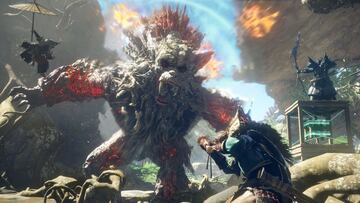
As I’m surveying the plains from the top of a hill, I spot my mark: a giant, flaming gorilla that’s bullying some poor animals. I’ve been hunting this creature for a few minutes now, and having encountered it before (and failing over and over again) I decided to plan out escape routes and build myself up with some food, a nice looking armor, and setting up some dragon Karakuri around the area where I know I’ll fight it. I jump on a zipline, and in seconds I’m striking the big brute. Everything is going according to plan, I’ve got it pinned down with some harpoons, and as I charge up a big strike with my staff… I get turned around and miss completely, and then I proceed to die again.
What I’ve just described is the exhilarating and incredible gameplay loop of Wild Hearts, Koei Tecmo and EA’s new game that aims to bring some competition to the monster hunting genre. Yes, it is almost impossible to not mention Capcom’s own Monster Hunter series, but that’s because Wild Hearts takes heavy inspiration from said franchise, and builds upon it with new mechanics and streamlined progress and systems to create something new. But while all of these decisions are incredibly satisfying on their own, together they struggle to work together, and more often than not can cause some issues with players that are new to the genre, or that may not be up to the challenge this game proposes.
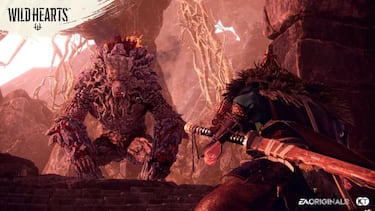
However, there’s plenty of good stuff to find in this new title if you’re looking to spice up your gaming life: from heart-pumping battles to next-level mobility and exploration, Wild Hearts will manage to keep you coming back for more even after some frustration.
You’re gonna need to put in the work
If you’ve ever played Monster Hunter, then you know what the main gist is here: you’re a hunter, so go out into the world and beat some big bad creatures into submission. Using your awesome weapons you’ll need to fight impossibly large monsters to get their materials, and use those to upgrade yourself, to fight even bigger enemies. Sadly, if you were hoping for a little less grind, you won't find that here.
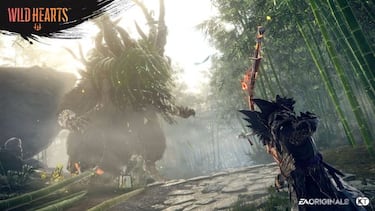
Wild Hearts gives you plenty of options when it comes to how you hunt, after all, there’s 8 different weapons to try. We’ve spoken about these before, but what you need to know is that each of them has their own identity that alters the way you play: using the Karakuri Katana with its whiplike attacks feels incredibly different than using the Bladed Wagasa, a bladed parasol that is more defensive thanks to its parrying ability. And both of these are so distant from the Maul or the Bow that changing between them can sometimes be a challenge.
What is true is that most of them work under the mechanic of managing energy meters and good positioning and footwork. Most weapons are about charging up your energy meter by getting a good flow of hits, so that once you fill up a bar you get to unleash some epic anime-style big hits. It’s just that how you manage to do so differs due to their weight and attack speed.
Most players will probably stick to one weapon type, and that’s fine. No matter what you end up choosing, you’ll constantly feel powerful and epic when fighting the Kemono. And to help in actually making you stronger without the need of changing much, the game has an upgrade system that gives elemental or raw buffs to your weapons by using materials on a skill tree. It’s the same ability tree for every weapon, but you can mix and match as much as you please to make the perfect build for any situation, and doing a respec is extremely easy.
But one thing is certain: if you want to get good at hunting Kemono, you’ll need a lot of trial and error, and some patience. This is not an easy game, and from start to finish some of these monsters can knock you out in just one or two hits. Failure is part of the journey, but if you’re willing to stick through it, the feeling you get with each victory is addicting.
A living, and lived-in, world
One of the most strikingly good aspects of Wild Hearts is its open world. Divided into massive regions, each thematic of a season of the year, the scale of the maps you play in is impressive, rivaled only by their incredibly dynamic design that gives them verticality and identity at every corner. In just the first area, which represents spring, you’ll find yourself exploring abandoned towns, running through shallow rivers covered by a forest, or entering marshes and caves each easily distinguishable from everything else. After playing for hours you’ll start to learn the lay of the land and will use this to your advantage when hunting Kemono.
But the most interesting part happens when you mix this huge open maps with the game’s Karakuri system. Early on you unlock the ability to build blocks around the map, and this is quickly and constantly upgraded with new things you can create during fights (temporary buildings like traps, blocks, walls and such) and most importantly “Dragon” Karakuri. These last ones include all sorts of stations and structures that stay in the maps permanently: from base camps you can fast travel to and forges to craft and upgrade weapons and armor, to ziplines, giant fans, springs to jump off of, and even automatic fishing machines to gather food while you’re away.
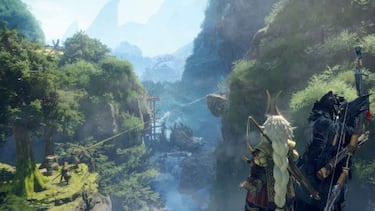
Little by little, you’re filling these maps with more man made structures that’ll help you in the long run. You’ll create your own routes to move around while hunting, eventually being able to predict and prepare depending on the Kemono. And all of this is usable by any player that joins your world. It’s actually a bit reminiscent of how Death Stranding handled its game world, given that other players can build their own structures in your world, and vice versa.
Speaking of, playing with others is incredibly easy. If you’re connected to the internet, anytime you start a hunt you can choose to ask for assistance. When you do, your session appears in the matchmaking menu for other players, where anyone can simply choose to join in. And done, in a few clicks you’re playing with someone else that actually wants to complete your same objective, without any major trouble.
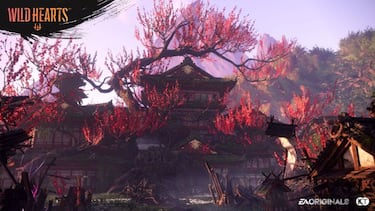
Sometimes, the plan just blows up on your face…
However, the problems aren’t really about what you do during the game, but how it happens: most notable of all of the issues is an abysmal performance on certain platforms. While we were playing on the early access version of the full game provided by EA, we encountered constant crashes and freezes, as well as some heavy slowdown during intense scenes. On a 2080Ti we were never able to break the 40 FPS bar, but most of the time we were playing between 15 and 26fps, constantly dipping in performance. There’s already been a Day 1 patch that helps out with this a little bit, but performance is still dreadful.
Thankfully, Koei Tecmo has already publicly announced that they’re working on trying to fix the performance on all platforms, given that the Xbox Series X and PS5 versions have also had problems. But something that probably won’t be fixed so easily is the camera issues in the game. The lock-on system will snap your view towards the Kemono anytime you use it, but they can be so big you’ll constantly be staring at a mass of fur and roots that makes it difficult to know what’s happening.
And when you’re in an enclosed area during a fight, it’s going to be even worse: the camera will jerk around and disorient you, typically resulting in you missing attacks and getting knocked around. It’s a slippery slope that happens way too often, and this is where the frustration builds up from. During a fight, you’re already trying to deal with so much: your positioning, the Kemono, your Karakuri builds, trying to use those and figuring out what to build next, your weapon gauges, and so on. Adding the camera issues results in you getting scrambled and overwhelmed, and can quickly turn an enjoyable experience into pure rage.
Wild Hearts has some pretty big issues: from the aforementioned janky camera to trying to juggle too much during the action, and some incredibly bad performance (that’ll hopefully be fixed soon), but none of it is enough to keep you from putting down the controller. Even after 50 hours of playing, apart from a lack of variety on the monsters you hunt you’re still hooked.
Related stories
Considering that this is an entirely new IP, we’re excited to see what the development team does to keep this game alive with updates, new Kemono to fight, and more. This one is a game that you won’t want to miss, and that will hopefully push its genre forwards with some heavy competition.
Wild Hearts will launch on February 17, 2023 for PlayStation 5, Xbox Series X, and PC.